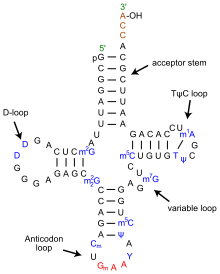
The cloverleaf model of tRNA is a model that depicts the molecular structure of tRNA.[1] The model revealed that the chain of tRNA consists of two ends—sometimes called "business ends"—and three arms. Two of the arms have a loop, D-loop (dihydro U loop) and Tψc-loop with a ribosome recognition site. The third arm, known as the "variable arm", has a stem with optional loop.[2] One end of the chains (with a double stranded structure in which the 5' and 3' ends are adjacent to each other), the amino acids acceptor stem, usually attaches to amino acids and such reactions are often catalyzed by a specific enzymes, aminoacyl tRNA synthetase.[3] For example, if the amino acid that attach to the end is alanine, the reaction will be catalyzed by alanine-tRNA synthase to produce tRNAphe.[4]
The other end—the bottom often called the "DNA arm"—consists of a three base sequence that pairs with a complementary base sequence in a mRNA.[5]
YouTube Encyclopedic
-
1/3Views:19 0961 22714 864
-
Clover Leaf Model of tRNA lecture, BSc Biotechnology by Priyanka Khan, Biyani Group of Colleges
-
Secondary structure of tRNA/Clover leaf model for NEET AIIMS JIPMER etc.
-
Structure of tRNA
Transcription
See also
References
- ^ "Explain briefly the clover leaf model of tRNA". Preservearticle.com. Retrieved June 2, 2015.
- ^ Prabhakar A, Krahn N, Zhang J, Vargas-Rodriguez O, Krupkin M, Fu Z, Acosta-Reyes FJ, Ge X, Choi J, Crnković A, Ehrenberg M, Puglisi EV, Söll D, Puglisi J (Jul 2022). "Uncovering translation roadblocks during the development of a synthetic tRNA". Nucleic Acids Res. online ahead of print (18): 10201–10211. doi:10.1093/nar/gkac576. PMC 9561287. PMID 35882385.
- ^ The Enzymes. Academic Press. 15 December 1972. ISBN 9780080865843. Retrieved June 2, 2015.
- ^ Echols, Harrison G. (August 2001). Operators and Promoters: The Story of Molecular Biology and Its. University of California Press. ISBN 9780520920767. Retrieved June 2, 2015.
- ^ A Survey of TRNA Mimicry: Structural Studies of Plant Viral RNA. ISBN 9781109205299. Retrieved June 2, 2015.
